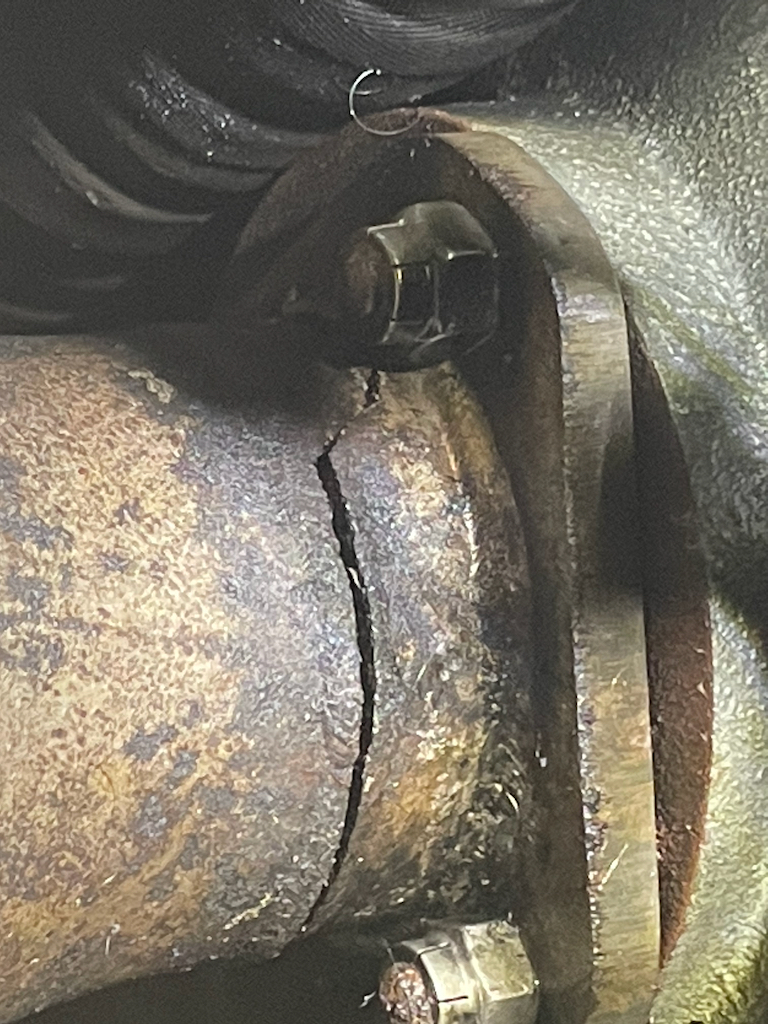
Exhaust Elbow Fracture at Flange to Turbocharger
Catalina 470
Engine Exhaust Elbow
31 March 2022
Onward's engine exhaust elbow failed catastrophically on arrival at Annapolis at the end of a cruise that started in April 2021 and proceeded through the Bahamas, along the East Coast to Maine and then to the Chesapeake in October 2021.
Thankfully it chose perhaps the best spot in that >~1500 nm cruise to fail.
Below is an article I wrote for the Catalina Mainsheet relating the saga.
Once safely in its winter slip, I removed the elbow and began the effort to find a replacement. I soon found there were no units available on the aftermarket. It was a custom designed and built for Catalina. I contacted Catalina Direct who is usually the go-to-place for specialty Catalina Parts. They cold find no past or potential new source for the elbow and advised me to find a local fabricator.
After a couple of false starts, I contacted Steve Madden, founder of the premier yacht rigging service in Annapolis, M-Yacht Services. I brought the failed elbow to him.
I also provided him a set of scaled location drawings to enable him to modify the original design to prove better raw water injection.
The apex of the inverted U-tube was raised 4" to provide more height above the muffler to make raw water back flow to turbocharger less likely.
It should be noted that when the failure occurred, there apparently was insufficient exhaust flow and pressure to force the exhaust + cooling water out of lift muffler to the stern exhaust port. This caused the exhaust + cooling water to rise up the elbow and flow down toward the fracture where it leaked into the bilge.
The raw water injection port was moved to the aft side where there is easier access.
See drawings and photos below.
1 April 2022
I have added an image of the original Catalina Yachts drawing for the exhaust elbow [provided by Marty Kwitek]
CMC470TN JJR-40 Dec21
Fortunate Failure
All good things… There are times and tides… Life is change… OK, there are lots of preludes that come to mind but that doesn’t make it any easier. I have lived aboard Onward, C470-126, since commissioning in 2003 – a lifestyle choice I have never regretted for a second. Between June 2007 and November 2019, we have cruised Onward from Maine to the Bahamas and back along the East Coast until being “captured” at our place on Marco Island during the Covid-19 pandemic in March 2020. We “escaped” in April 2021 and headed off for a return to the Bahamas. Along the way a self-realization that began to grow during our enforced stay ashore was confirmed. I always told friends I would continue our wandering lifestyle as long as we continued to enjoy it – and could do it safely. It was hard to accept, but while Peggy and I continued to love the full-time cruising life style, the safety margin for the two of us being able to do the long trek each year had diminished. So, we recognized our return to cruising the winter in the Bahamas in 2021 was to mark a change in our lifestyle: we would use Onward as our summer home in New England and would live 5-6 months ashore between Marco Island and visits to our children and grandchildren on the two coasts.
Decision made, we had a wonderful summer in Maine and Rhode Island and in September sailed Onward back to the Chesapeake where we planned to keep Onward in the water at a marina for the winter. The overnight passage from Port Washington to the Chesapeake was as perfect as one could want for sailing south along the coast of NJ and the Delaware. We anchored in the mouth of the Bohemia River for a good night’s rest and awoke to a perfect day for sailing south on the Chesapeake. It was so good we decided to head to Annapolis instead of Baltimore where Onward was to winter. There aren’t many times when Onward under sail has been able to outrace a tug and barge so we enjoyed 10+ kts SOG as. At Annapolis, I powered up and headed in only to miss out on the last open mooring in the harbor so we anchored off the USNA.
It was time to enjoy a cocktail while watching the theater of Annapolis harbor on a weekend. As I sipped my beverage and enjoyed the end of a perfect passage, I heard the bilge pump go on and I was a bit surprised -- but we had come a long way so I did not think too much about it. About 5 minutes later, the bilge pump came on again – and that got my attention. I went below and checked the bilge but didn’t see anything significant. Next, I checked the engine compartment and was startled to see a good bit of water in the pan under the engine. There was also the strong stink of diesel exhaust. I could not find any active leak so I decided to watch it overnight and do a thorough check in the morning.
My morning inspection revealed that seawater had been spraying from some leak on the port-aft quarter of the engine onto the aft engine access panel. Some of this spray had gone into the pan under the engine where it eventually overflowed out of the aft end into the bilge through the weep holes. Some of what sprayed on to the access panel had leaked around the edge of the panel onto the aft cabin sole and into the access port for the shaft seal.
My first thought was that the PYI shaft seal, the original, which has performed flawlessly over >80,000 nm had failed. However, when I had Peggy start the engine to evaluate this, the true source of the failure became vividly apparent as a spray of water came from the flange that connects the turbocharger to the exhaust elbow! The flow of water and exhaust was too great to be able to run the engine; we immediately shut it down and the water and exhaust leak stopped.
My initial exasperation and frustration upon reflection turned to thanksgiving. This failure could have occurred at innumerable places and times after departing Maine where it could have been a severe threat to our safety as we transited hazardous areas or moved in bad weather. I realized we were indeed fortunate that this almost catastrophic failure had chosen one of the most benign places to occur – Annapolis harbor where we were surrounded by every type of support one could want!
Close inspection showed that the joint where the stainless-steel exhaust elbow was welded to the mating flange for attachment to the turbocharge had fractured 360º around its circumference in an almost perfect circle.
Image 1. Exhaust Elbow Fracture.
My first thought was to have Onward towed to a marina to be hauled early for the winter. Unfortunately, it was Boat Show time so this was not a viable option. I, then, decided to attempt a temporary repair to allow us to sail to our planned berth in Baltimore.
I removed the thermal protection near the fracture, cleaned the surfaces as well as I could and then applied a layer JB Weld epoxy. I, then, overwrapped the first layer of epoxy with a strip of 2” brass foil and hose-clamped it in place before applying a second overcoat of JB Weld. I let the repair set for 24 hours. When the engine was started to test the repair, it immediately failed! There was evidence that sea water had filled the muffler because the exhaust was leaking out at the break. We had been rolled about due to the wakes from harbor traffic. This was apparently enough for water to be tipped out of the muffler-elbow and flow down to the epoxy with the result being poor adhesion.
Image 2. Exhaust Elbow -- Attempted Emergency Repair.
With the failure of the quick fix, I decided it was time to use the Tow Boat US Unlimited Towing option. A local towboat operator was alongside within an hour and took us to the mouth of the Magothy River where the Baltimore operator took over. Within 4 hours of my call, we were safely in our slip at the marina.
The next step was to remove the entire exhaust elbow. I removed the raw water injection hose from the top of the inverted U of the elbow. Next, was the strut that connects the elbow from a stud on the elbow to the aft-port engine mounting bolt. The nut holding the strut to the stud was a low-profile lock nut. In the restricted work space, it was very difficult to get a wrench to grip the narrow surface of the hex. The nut on the engine mount bolt had become frozen due to salt-water corrosion. Use of PB Blaster and an impact wrench could not break it loose. I had to use a Ryobi-One oscillating tool with a metal cutting blade to cut the strut in two – after I drilled two holes in it to allow a scab-plate to be used to bolt it together once a new or repaired exhaust elbow was installed. I also used the oscillating tool to cut through the hump hose that connected the elbow to the muffler. This allowed the exhaust elbow to be removed. The flange to the turbocharger was easily unbolted.
Image 3. Exhaust Elbow after Removal – As viewed from front / bow end when mounted on engine.
Inspection of the removed exhaust elbow showed that from its initial fabrication, the weld of the tubing to the turbo mounting flange had been defective. There was about 25% of the tubing circumference where weld metal had not filled the gap between the tubing and the flange. This weaker section of the weld created a focus for corrosion and fracture. However, it should be noted that it survived > 10,000 engine hours before failure.
The defective weld apparently had begun to leak some time previous to the catastrophic failure. The defect was hidden both by being on the forward, not -visible, side of the tubing and being substantially covered over by the thermal protection material. It remained undetected because it was a small leak on hot engine parts in a hard to observe area.
Normally with the engine running, the exhaust pressure pushes water out of the lift muffler. However, due to the location of the raw water injection nozzle, some spray could splash back toward the flaw at the turbocharger. I believe this was probably the source of the salt water that corroded the engine mount bolt.
It also explains why during the last several months, I’d had perceived a faint odor of engine exhaust in the aft cabin and when opening the engine compartment after extended engine use. Many searches for a source of this smell had proved unsuccessful.
I was unable to source a replacement exhaust elbow as they had been custom-made specifically to fit the C470 engine and exhaust system geometry. The geometry of the mounting area is very complex and restricted so variation from the original must be minimal. I engaged a stainless-steel metal fabricator in Annapolis to build a new unit. The design will be improved to reduce the possibility of raw water flow back toward the turbocharger.
In summary: engine exhaust elbow failure on the C470 can be catastrophic and lead to a severe threat to vessel safety due to loss of power and exhaust fumes and flooding hazards if situations are adverse. Owners should inspect the exhaust elbow-turbo charger connection regularly as this is the most highly stressed area of the exhaust system due to thermal and vibration loads. A persistent minor exhaust odor in the area after engine use may be an indicator of an insipient failure. Beware of any mysterious salt water corrosion in the area as a potential symptom of a hidden raw water leak. The hump hose that connects the exhaust elbow to the muffler should be inspected regularly for chafing damage.
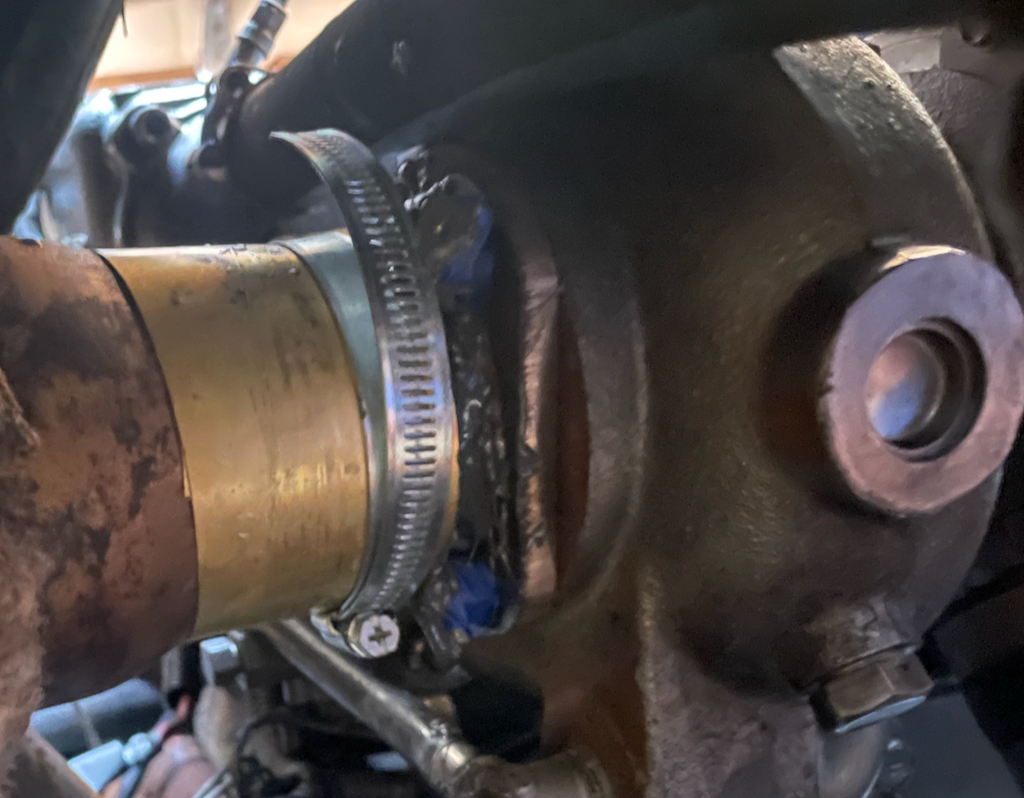
Exhaust Elbow Attempted Temporary Patch
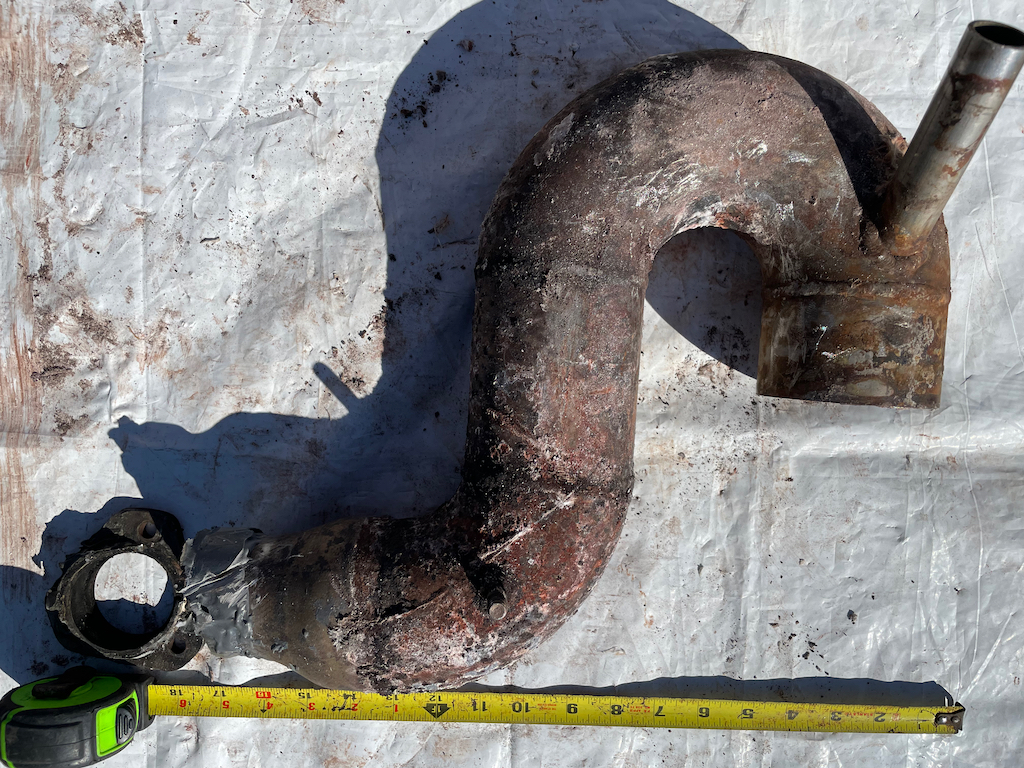
Exhaust Elbow After Removal and Heat Protection Removed —Bow View
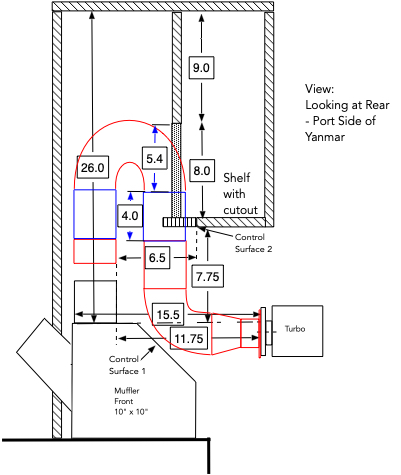
Scaled Drawing of Exhaust Elbow, view from aft of engine showing cabinet bulkheads, muffler, and turbocharger
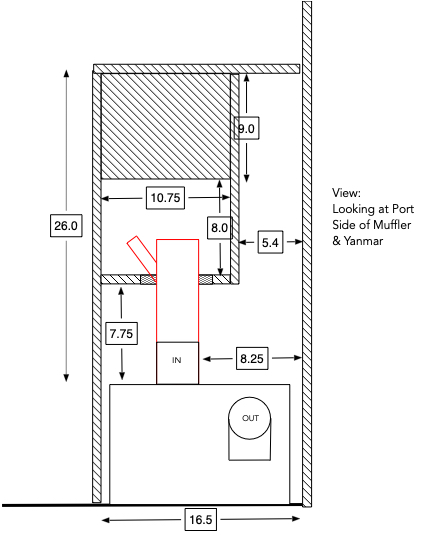
Scaled Drawing of Exhaust Elbow, view from port side of engine showing cabinet bulkheads, and muffler
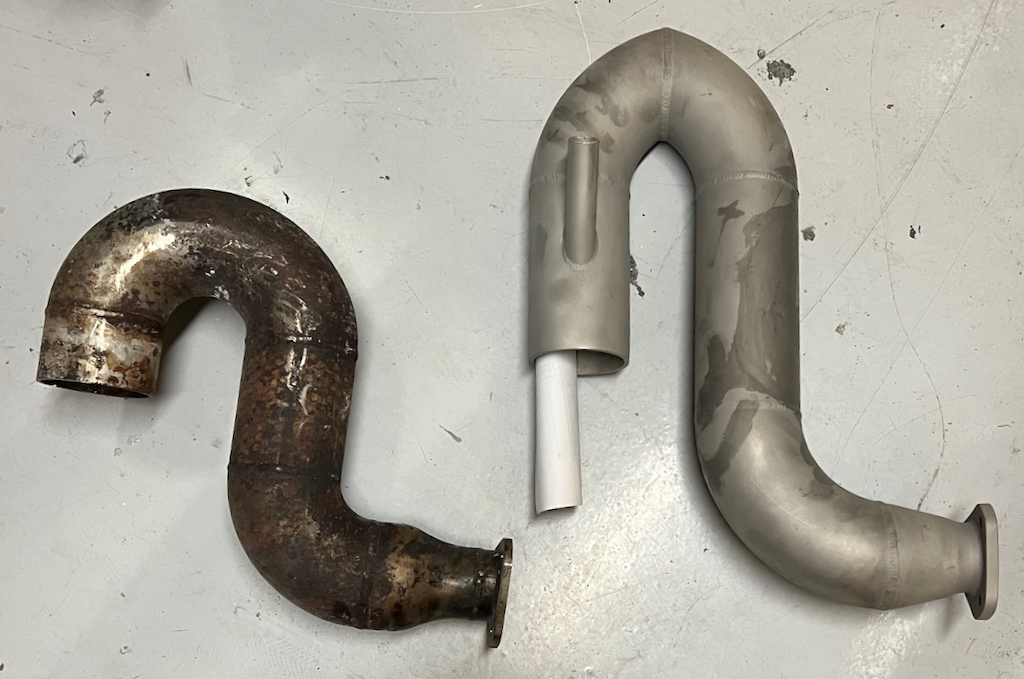
Exhaust Elbow, old & new fabrication; Stern View. Note: height has been increased 4" and raw water injection moved to stern side.
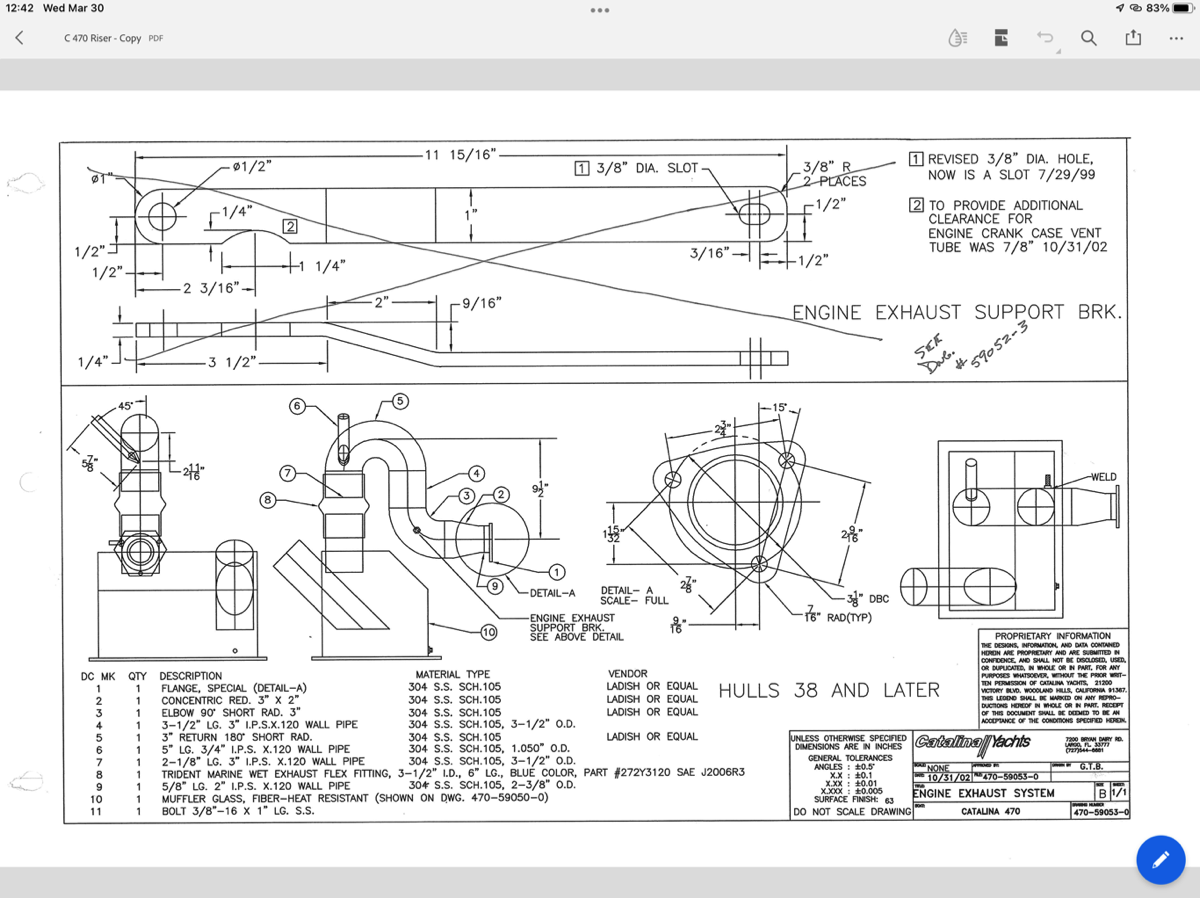
Catalina Yachts Drawing for Engine Exhaust Elbow
